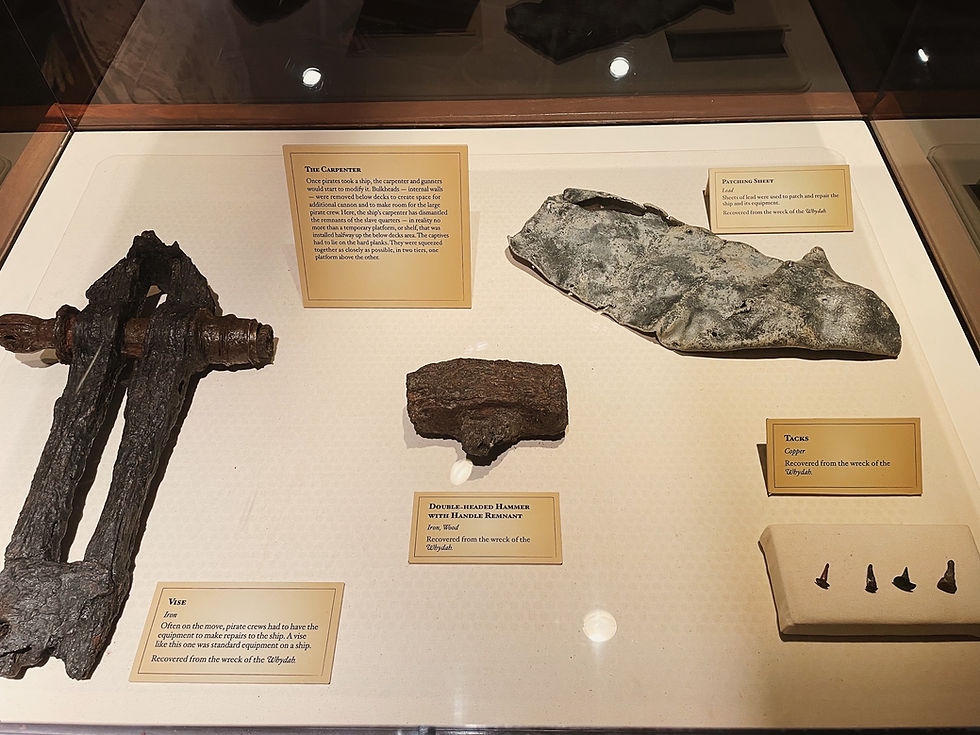A Glimpse Inside a Small Musical Instrument Shop
- marcsitkin
- Dec 17, 2020
- 4 min read
Updated: May 11, 2023

Figure 1. Mathias Kramberger’s violin shop in Youngstown, Ohio. The photograph was printed from the glass plate negative, Figure 2.
Excerpted from The Chronicle Vol. 55, no. 2, June 2002
by Carl Bopp
The three objects in Figures 2, 3, and 4 were bought as a group at an antiques show. They are thought to be related to each other. They are: 4-1/4 x 6-1/2 inch glass negative, a business card, and a registering caliper. Written in pencil on the back of the card is an undated receipt.
Bridge: 50 Chinrest: 75 Set Strg: 1.00 Tuning [ ? ]: 35 Pegs Fixten: 20 Bow Rehair: 1.50 Paid: $4.30
On the glass negative and a new print made from it (Figure 1), we can see part of the interior of a small musical instrument shop. The shop was evidently not dealing with the carriage trade. It’s only about the size of a single car garage, and surely never won an architectural or interior design award. In the left foreground is a showcase. Most of what is in the case cannot be made out, but some instrument strings seem to be laying on the top. Inside the case, small boxes probably hold articles for sale and use or both.

Figure 2. The glass plate negative.
On the wall, extreme left, about the show case half of a sign is visible. Only the letters “CTLY CASH” can be seen. It most likely is the well known saying, “ALL WORK STRICTLY CASH.”
The first four instruments (left to right) are guitars. I’m told that the first two and the fourth are “Grand Concert Style.” The smaller one (third from left) is a “Double-O Style.” Half covered by the calendar in the foreground is a mandolin. The calendar is open to June 1909. Because the calendar occupies a prominent location in the shop, it seems feasible to use it to date the photograph. Sitting on the floor is a bass and over by the window is a cello. Over the door is a sign that declares, “Repairing Neatly Done.”

The business card proclaims Auto phone 77751/All repairing of String instruments/Mathias Kramberger/ Expert Violin Maker/30 years experience/First Class Bow Repairing/234 East Federal St. Youngstown, Ohio
Peering out from a small back room is a man sitting at a workbench (Figures 1 and 5). He is holding an unfinished violin. In all probability the man is Mathias Kramberger himself. Behind him hangs a pat-tern or part of a bass. To the right of that is a form to bend the sides of violins. A bass is also behind him. Only three tools are visible. The first two, hanging on the wall, are a back saw and a hand saw. These two tools are necessary for but not usually thought of as musical instrumentmakers’ tools. The man is holding the third tool in his right hand. It is a registering cali-per similar to but not the same as the one in Figure 4. The calipers the instrumentmaker is holding look like the type shown in R. A. Salaman’s Dictionary of Tools,(page 500). On this model the needle moves on only about a quarter of an arch. Salaman calls it a “Calliper Gauge.” Note the British use two l’s in spelling caliper.

Figure 4. The registering calipers that are similar to the one Mr. Kramberger is holding in the photograph.
The Figure 4 caliper is a very well made tool. It is 9-1/8 inches long overall. It is spring activated to close. By pushing on the trigger-like lever at the bottom, the arms open as a rack and pinion gear moves a needle over an arch marked in metric. Inserting the arms over and under the object to be measured and releasing the lever closes the arms and gives a reading of the thickness in centimeters. A tool like this is needed to measure the thickness of carved out front and backs of violins. The tool is marked “Indicating Calipers Co., New York Pat. Aug. 8, 1916.” The Directory of American Toolmakers lists Indicating Caliper Co. in New York, but makes no mention of patent date.

Figure 5. A close-up of Mr. Kramberger. The violin he holds consist at this point of only its back and sides. Note the calipers.
Thanks to some unknown photographer who captured this image, we are reminded that it was in count-less one-man shops like this that many of the tools we collect today were used to eke out a living. It’s doubtful Mathias Kramberger’s violins will ever reach the status of Antonius Stradivarius’s, but we can hope that some of his violins are still making sweet music. And who knows where his others tools are today.

Figure 6. At the bottom of this page from the Goodnow & Wightman (Boston, Massachusetts), 1882 catalog is an earlier type of registering calipers. Author’s collection.
Author Carl Bopp has been an EAIA member since 1971. He served as president from 1995–1997 and was the 2000 recipient of a longtime service award.




Comments